Episode #401: It’s Not Either-Or: Building a Math Classroom That Has It All
LISTEN NOW HERE…
WATCH NOW…
A teacher asked us a fair question: “If direct instruction and practice are working, why change?
While presenting at a recent conference, we were approached by a teacher with a very honest question:
“I’ve been using direct instruction and structured practice with great success. My students are doing well. What reason do I have to change?”
In this episode, we unpack how we responded and why it’s not about replacing what’s working—but expanding what’s possible. We explore how a balanced approach to math instruction includes explicit teaching, purposeful practice, rich tasks, and number talks—and how each of these elements can strengthen one another when used intentionally.
Tune in to hear why this isn’t a debate between approaches—it’s about building a robust math experience where students can develop fluency, flexibility, and deep conceptual understanding.
You’ll discover:
- Why direct instruction and rich tasks in math class are not opposing strategies
- How to integrate number talks, purposeful practice, and inquiry-based learning
- The risks of relying solely on one method of instruction
- How balance creates opportunities for students to reason, communicate, and make connections
- Practical suggestions for teachers ready to evolve without discarding what already works
Attention District Math Leaders:
Not sure what matters most when designing math improvement plans? Take this assessment and get a free customized report: https://makemathmoments.com/grow/
Ready to design your math improvement plan with guidance, support and using structure? Learn how to follow our 4 stage process. https://growyourmathprogram.com
Looking to supplement your curriculum with problem based lessons and units? Make Math Moments Problem Based Lessons & Units
Be Our Next Podcast Guest!
Join as an Interview Guest or on a Mentoring Moment Call
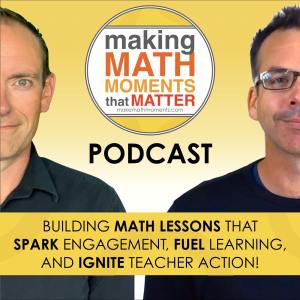
Apply to be a Featured Interview Guest
Book a Mentoring Moment Coaching Call
Are You an Official Math Moment Maker?
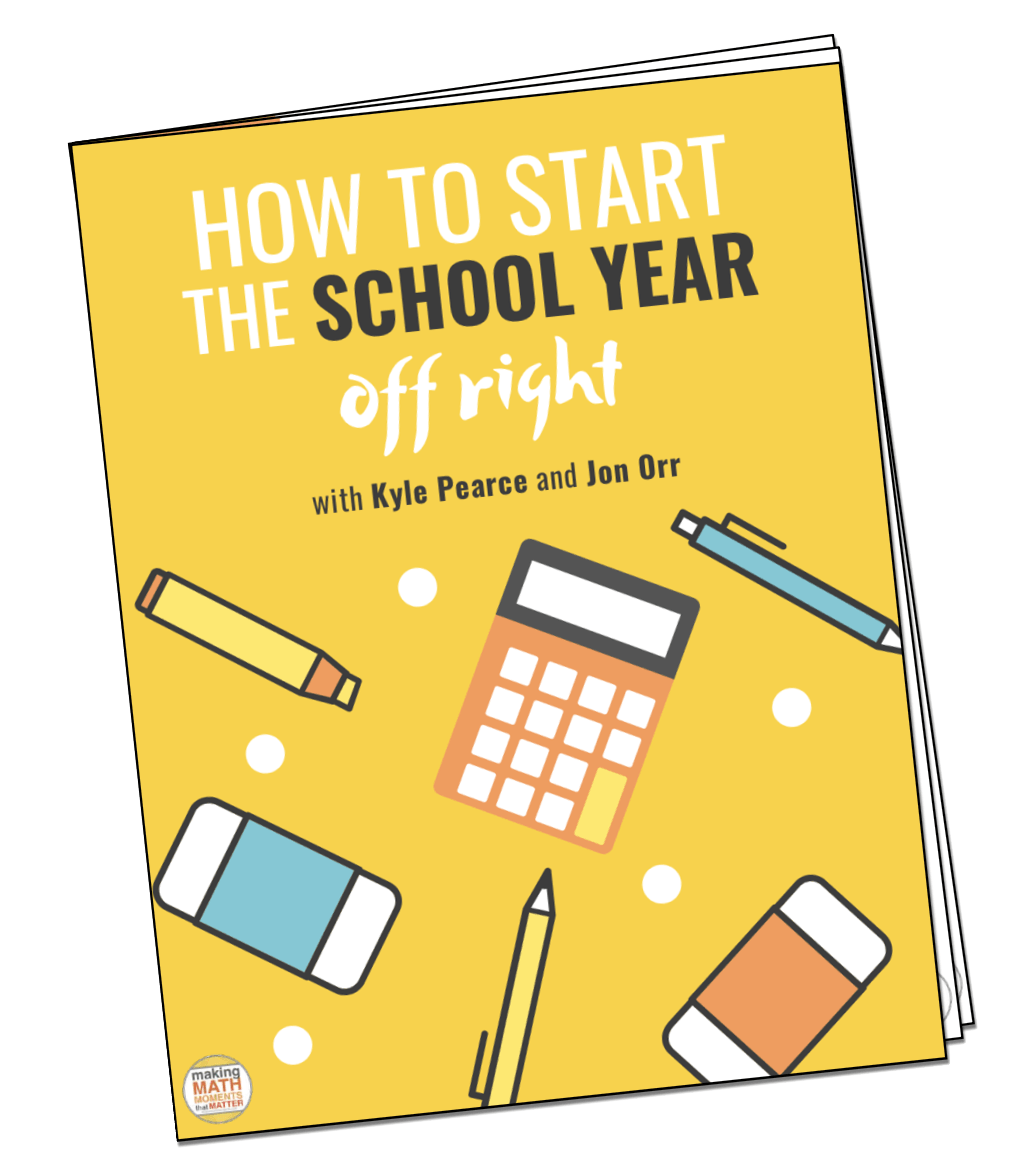
FULL TRANSCRIPT
Yvette Lehman: Couple weeks ago, we had a chance to work with some teachers from the Southwest region of the US in Phoenix. And during one of my sessions, we were separated at this point, John, so you didn’t get to hear this question. But a teacher came up to me and very earnestly, not in a confrontational or backup kind of way, said to me, they’d been in your session where you’d done a task-based approach. And then in the session that I was facilitating, we were doing a visual number talk.
And the teacher basically said, I love what I saw today, but it’s very different from what I currently do. And what I’m currently doing is working. My students are successful. I’m happy with my results. Convince me why I need to make a change.
Jon Orr: Hmm, common, right? Super, super common question when and I think as a as a teacher, you know, when we’re thinking about any sort of professional development that we’re attending, you know, it’s a, you’re probably, you’re probably listening to this in August, you know, it’s it’s getting it’s either the school year has just begun or the school year is about to begin. And maybe you’re in your kickoff PD sessions or you know, you have some PD sessions on numeracy coming up.
And you know that someone’s going to be talking about like, what do our lessons look like? What could we be doing differently? Like this is the heart of what PD actually happens. And I think a lot of us go, does that mean like what I’m doing isn’t the right thing? And like, it, but I feel like I have success. So am I wrong? Am I right? Like these are common wonders we have anytime we’re engaged in any sort of professional development is we take that step back. And if you’re leading professional development, you always hear this, right? You always hear like, why?
should I shift what I’m trying to do, like what I’m doing towards this? And we often, as classroom teachers, wonder that and we wonder like, well, why do I need to do that? Like, you’re right, convince me because I’m not convinced yet.
Yvette Lehman: feel like my initial reaction to this teacher, because I felt kind of on the spot and again it was a very genuine conversation, but my first reaction was well if what you’re doing is working
I don’t recommend that you throw it away or abandon it. I think we’re too quick to do that. Like I think sometimes we do have these huge pendulum swings in education. And it’s like we actually lose sight of the things that were working for us before. We’re seeing that right now in literacy where it’s like, yes, we’re advocating for a phonics based approach right now to improve fluency, but that doesn’t mean we need to abandon all of the great comprehension work we’ve been doing over the past 10 years. my first question, you my response to this teacher was,
Well, if it’s working for you, I wouldn’t abandon it, but how can you augment it? I remember I had a partner at the district level and we would sometimes get this pushback from students. I’m sure you did as well, John. Yeah, like I’ve had kids and my colleague would say to these kids who were like, well, you know, this way works for me and I’m really good at it and I’m really efficient and I’m very accurate. Why do I need to do it a different way? And I remember he would always say to them, you know, right now,
Jon Orr: For sure, for sure.
Yvette Lehman: you are a great mathematician, but would you like to be exceptional? And it’s like, maybe right now this teacher has a really strong program, but are there ways without completely abandoning the current approach that you could make it even stronger? And what is that first shift or what’s a reasonable shift that’s not going to disrupt everything you’re doing, but that could augment what you’re offering to students currently.
Jon Orr: stronger. Right. Right, like in order for us to be in that position, we have to think, well, what are my holes right now? Like, do I have any possible improvements to make? And where, if I had to choose improvement, and this is, and usually this comes from the, question you get is that they’re not, that teacher probably wasn’t seeing that what we were talking about in that day actually plugged one of the holes, the faith view as.
what they need to have plugged for their professional development, which is that disconnect when we attend professional development. like, just feel like this isn’t for me. It’s not actually helping me do the things I wanna do or could be doing or to be better. So when you think about that question about if I wanna be better, what are the things that, like I gotta know where do I wanna get better?
And is this over here, this thing that I’m being provided, actually helping me get better on that thing that I’ve identified? And when those two things align is when we have great professional development, is because now you see it as a whole plugger and you’re like, I’m gonna go try that. So this teacher obviously wasn’t seeing that connection because they weren’t identifying that, or they were just saying like, I like the question that they asked, which was, convince me, because maybe I’m just not seeing that the thing you’re doing actually will plug. one of my existing holes.
Yvette Lehman: And I hope I was successful. I’d love to circle back to this teacher a month from now, two months into the school year and say, know, were you convinced? Did you see the value? So the way that I approach it is, you know, the task that you engaged in today was a thinking task. It was a reasoning task. It positioned students as the thinkers, as the problem solvers in your classroom. Do you see a space for that? Do you see value in integrating that type of routine into your current practice and why?
And I think that maybe what scared the teacher is that they didn’t see anything that they do in what we demonstrated. They didn’t see that we still do explicit instruction during consolidation and during small group instruction. They didn’t see that students still engage in structured, purposeful, scaffolded practice. Like those things still exist within our comprehensive math program as well. They sawyou know, the really discourse heavy student centered aspects of a task in a visual number talk.
Jon Orr: Mm hmm. Yeah, that might have been our fault to not do a zoom out, you know, and this is where this piece might live inside our, our, you know, our comprehensive math program or math lessons or math structures that we’re utilizing over the course of five, five day week, or, you know, over these three days or two days or, even just inside the one lesson of that one day, we were focusing on small shifts that we could be making.
to begin our lessons in a way and they were taking that as the I have to completely overhaul everything I’m doing if I’m gonna take their advice and that’s in a way not what we were trying to give to the teachers to say like this is what we want you to realize that there are small changes to be made and this is and I’ll go
I’ll zoom out a little bit and thinking about bigger picture with PD and hearing different ideas is that oftentimes when we attend these types of sessions, we look at what’s happening there and we jump to that conclusion that that I’m not seeing what I’m doing there. So therefore I must be wrong. And but they’re also saying like I’m seeing that piece and then going I therefore should look like that too. Like the way that that that was facilitated.
my, should immediately be able to do that. And I think what many sessions fail to do, and maybe we failed to do that in that session, is to show, that you’re seeing the finished product over years of trial and error, or years over implementing different problem-based tasks to figure out what worked and what didn’t. And a lot of times, I think we have to go through the years. Like we have to start at the beginning and go like, well,
We were hoping to present to you a small nugget of how to start your lesson and change it just a little bit. Doesn’t mean that you’re gonna do that every day. Doesn’t mean you’re gonna do that for the entire lesson. was like, let’s just, because that’s what we did at the beginning. It was like, let’s try this here and then tomorrow we’re gonna do our direct instruction. We’re gonna rush to our algorithm. We’re gonna do it this way. Like, it wasn’t until years of trying these different things where you start to go like, I’m gonna put that here and I’m gonna put that here and I’m gonna do another one of those things because I’ve taught this lesson before this way.
And I didn’t like it, I need to plug a hole, but when I tried that last year, that one move I saw at that PD, it worked great there, maybe it’ll work here today. So let’s try that again. And then let’s try that, like over time you start to get comfortable with these routines or these strategies or these ways you shift your pre-existing lessons that you already have. this is where the success comes from, because the years of that continual work.
you now have more of robust program where kids are doing more of what you want them to be doing because you’ve worked at it over that time. And sometimes when we’re in those sessions, we see the end result, like you see the, you you see that tip of the iceberg, but you don’t see what was underneath to get there. And sometimes that’s the fault of professional development sessions you’re sitting in is you’re not being told. You have to actually like sit back and go like, nope, what I’m seeing, like be critical. What I’m seeing is,
a finished product. I’m not seeing all the muck that this person went through to get there, but I have to go through that muck. So I’d rather see the muck actually.
Yvette Lehman: Yeah, that’s great reflection for us as the facilitators just to be more transparent about our journey and the process and what they’re going to experience that day. And maybe what an appropriate first step is if you wanted to make that shift. If you saw value in the routine or the practice or the facilitation of that particular component, what would be an appropriate first step? It was interesting though, because of course the teacher told me their first step and then I…
challenge their first step, which is so me, you know, like I just, that’s my personality. But basically, you know, what his, his conclusion was is that, you know, he said, I do application type questions, you know, rich questions, but they’re more, you know, sit and do in your workbook. And he’s like, maybe at the end of the unit, I could take one of those application questions and make it more curious, make it more collaborative. And of course I was like, well, what about at the start?
You know, which is a practice that we started early on, which is like, let’s do one at the beginning. That way we can, we don’t make assumptions about what students know. It’s like, let’s, let’s trust that through reasoning, students are capable, even if I haven’t explicitly taught them exactly how to do this problem. Trust at the beginning that they’re going to bring with them some, some prior knowledge and some reasoning skills. Use that to gather information about their entry point into this particular learning.
then do my explicit instruction, my purposeful practice, my small group, my centers to reinforce key concepts, and then also do it at the end. And so that was kind of my pushback on the idea of like, well, maybe I could do this at the end. was like, maybe you could do it at the beginning. maybe, know, maybe like that’s bold.
Jon Orr: Sometimes it feels risky to do that, but it also could pay off. I remember having that thought, and this is my high school classes, I was teaching trigonometry to kids taking advanced functions, and so this is pre-calculus, if you’re in the States and we were looking at solving trigonometric equations. And historically, you’re solving trigonometric equations, a very common example is a ferris wheel is turning.
you know, around and the rider gets on at the bottom, you know, and they make a few revolutions, where do they end up at this time? Like, when do they reach a certain height? Like these are questions that you can solve with, trigonometric functions. And I used to teach it very traditionally and, and, and say, let’s, let’s solve these types of equations. Let’s solve this type of equation or let’s, let’s make sure we can draw the graph. And then all of a sudden the end we’ll do a Ferris wheel problem. So I remember specifically one time going, you know what, why don’t we introduce the Ferris wheel problem?
let’s develop the question that we want to solve, which is like, hey, when does this rider reach a height of 40 meters, for example, which in order to solve that question, you would have to solve a complex trigonometric equation, but we didn’t have the skills to do it. And so initially you’re like, there’s no way I could do that problem at the beginning of the lesson because we don’t have the tools required to do it. But what we did is like, let’s, we did that whole, like what you just said, like what if we did, and what does that mean about the progression?
of my lessons for the next few days or the next, you know, the way that my examples would unfold or the curiosity that we’re trying to build. And so we did all of the curiosity component of that problem to develop the question. And then it basically gave us the required motivation to look at, if we wanted to solve this, what would we need? What would we need to know? What would we need to do? And what skills are we going to need to develop? And then we can unfold, you know, different examples and different
skills to say by the end of the unit, solve that problem. So start with it, use it as a motivator and then still end with it was a great way. And I think a lot of resources are actually set up that way to pose a chapter problem and then use it to kind of fuel the work that’s gonna happen. And sometimes that’s one of those moves that helped me make shifts to do more problems at the beginning and then use it as connections throughout.
Yvette Lehman: I think that my big takeaway from that session that we did and that question that came from the teacher is I’m guessing people listening right now might not be the reluctant teacher. Like they’re probably listening to this podcast because they also are looking for innovation and they’re looking for ways to strengthen their practice and they probably have similar beliefs as we do.
But what about their neighbor next door or the teachers in their PLC? So I guess, you know, for the people listening today, maybe you’re being asked these questions. Maybe you’re trying to innovate and you’re trying to bring best practice into your building and you’re getting these same questions. And so hopefully this episode helped us kind of unpack how those conversations might go. This idea of, know, we don’t want to completely disrupt.
what’s working and tell people to completely transform their practice because likely it’s not going to happen. But can we create experiences where our colleagues, our teaching partners see the value, they see the engagement, they see and value student thinking through the experience and be realistic about the change that we’re hoping that they make over time in the small doses. And to our leaders listening, I don’t think it’s realistic to think that
every single day when we walk into a classroom, we’re going to see a task-based approach. Like, I don’t know that you would see that in my classroom. And I think that that’s a change that I’ve had over the past 10 years is that, you know, I might do a task, a really rich three-part math lesson twice a week, but then the other day is I’m doing a small group, I’m doing purposeful practice, I’m doing number talks, I’m doing centers and things like that. And so, you know, when people attend our PD and we model the task-based approach, just knowing
that that is not how we deliver every single lesson every single day. It might be for some, you know, and that may work in the context of your classroom or the learners that you have in front of you, but it wouldn’t be what my program would look like in a five-day cycle.
Jon Orr: Right? Yeah, like my, I think my big takeaway would be specifically, because we haven’t addressed this aspect about the question yet either, was that he said, like I’m gonna put asterisks around or quotations around working. Like what does working mean to you? Right, like that part right there has to be defined because what we’re saying probably is, like when we look at your lesson,
we’re probably noticing that your lesson actually isn’t working the way that we’re defining what working is. And you’re defining it as working because you’ve got a preconceived understanding where this is where your why is or what you’re doing in your class. And actually it might not align. And so the big idea that I want folks to kind of take away when we’re introducing or we’re doing PD or when you’re sitting in a PD is to reflect on your, what is your why of the, why am I doing this type of structure? Why am I teaching this way?
Like what am I actually solving with my students? Like what am I actually giving to my students when I engage in this type of learning with them? Because for us, a lot of the why those shifts happened over the course of many years, because I realized that what I was doing in my room wasn’t actually serving the why behind what I was hoping to give to my students, which was a big, I used to say it all the time, is I wanted problem solving. What are we doing in math? Well, we’re teaching kids how to solve problems.
when I was reflecting on the actual problem solving process, then I was realizing that I was not, I was not actually doing that. So even though I was teaching the Ferris wheel problem, I probably wasn’t achieving my why, which was engaging more students in problem solving and helping them work through actual problem solving, becoming better at problem solving. Because in mathematics, the way I was teaching it for many years, and the way that maybe this teacher was teaching it, if they’re teaching
solely with direct instruction is your, and maybe his why was not helping kids become better problem solvers. Maybe he has a different why and that’s why it was working for him. But for me, you if I’m teaching solely with direct instruction, I’m not teaching my students to be better problem solvers because what is problem solving? Like, I’m giving kids a bunch of inputs, you know, when we’re teaching from our examples, when we’re doing in direct instruction, we’re saying, here’s a bunch of inputs. Let me show you how to manipulate these inputs.
So you get a very particular output. And that’s what I was doing with all my examples. But what is problem solving? Well, real problem solving to me, and this is my why, is really understanding. The problem part, the problem solving part is understanding what inputs do I really need? And that part we’ve always missed in the lessons when we’re going straight to the algorithms, straight to, say, direct instructions. We’re telling them all the inputs.
and not letting them wonder what the inputs are required to solve this problem in this way. And that’s what we were doing on that day. We were holding that information back a little bit to create that little gap in knowledge to create more opportunity for people to go, what do I need to solve this problem? And so when I think about what works, I shifted my instruction to do more of that because that was solving my why.
And that would be my big takeaway is like when we’re actually sitting in our PD, like think about what your why is and whether this is actually helping it. And how can I structure my lessons to do more of my why than say less and less and less of my why. And that’s that is the course of a career in teaching is trying to continually move this continuum, move yourself on one side of your why to the other. And those whys change over years too. It’s like, I realized that what I was doing was not actually my way.
and I need to shift. And that’s why when I go to a PD, I need to know what those things are so that I can fill those gaps, fill those holes. So my big takeaway here is to say, let’s step back and go, let’s make sure we know what our why is and what we’re trying to do, and then we can make adjustments to our lessons to achieve that why.
Thanks For Listening
- Book a Math Mentoring Moment
- Apply to be a Featured Interview Guest
- Leave a note in the comment section below.
- Share this show on Twitter, or Facebook.
To help out the show:
- Leave an honest review on iTunes. Your ratings and reviews really help and we read each one.
- Subscribe on iTunes, Google Play, and Spotify.
DOWNLOAD THE 3 ACT MATH TASK TIP SHEET SO THEY RUN WITHOUT A HITCH!
Download the 2-page printable 3 Act Math Tip Sheet to ensure that you have the best start to your journey using 3 Act math Tasks to spark curiosity and fuel sense making in your math classroom!
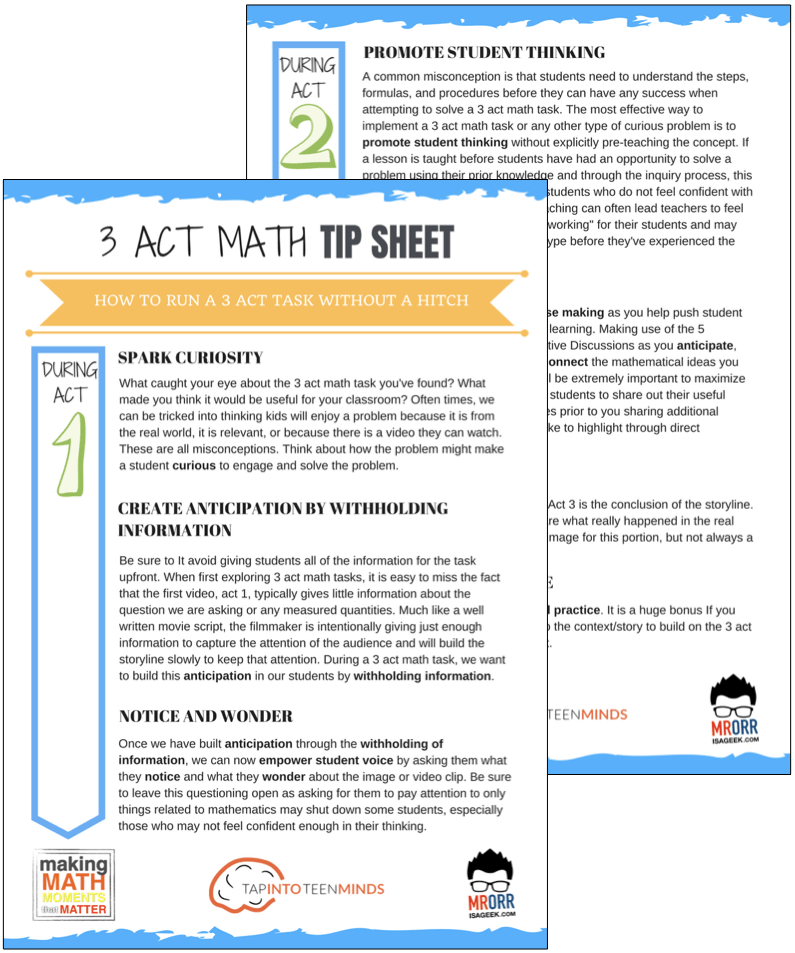
LESSONS TO MAKE MATH MOMENTS
Each lesson consists of:
Each Make Math Moments Problem Based Lesson consists of a Teacher Guide to lead you step-by-step through the planning process to ensure your lesson runs without a hitch!
Each Teacher Guide consists of:
- Intentionality of the lesson;
- A step-by-step walk through of each phase of the lesson;
- Visuals, animations, and videos unpacking big ideas, strategies, and models we intend to emerge during the lesson;
- Sample student approaches to assist in anticipating what your students might do;
- Resources and downloads including Keynote, Powerpoint, Media Files, and Teacher Guide printable PDF; and,
- Much more!
Each Make Math Moments Problem Based Lesson begins with a story, visual, video, or other method to Spark Curiosity through context.
Students will often Notice and Wonder before making an estimate to draw them in and invest in the problem.
After student voice has been heard and acknowledged, we will set students off on a Productive Struggle via a prompt related to the Spark context.
These prompts are given each lesson with the following conditions:
- No calculators are to be used; and,
- Students are to focus on how they can convince their math community that their solution is valid.
Students are left to engage in a productive struggle as the facilitator circulates to observe and engage in conversation as a means of assessing formatively.
The facilitator is instructed through the Teacher Guide on what specific strategies and models could be used to make connections and consolidate the learning from the lesson.
Often times, animations and walk through videos are provided in the Teacher Guide to assist with planning and delivering the consolidation.
A review image, video, or animation is provided as a conclusion to the task from the lesson.
While this might feel like a natural ending to the context students have been exploring, it is just the beginning as we look to leverage this context via extensions and additional lessons to dig deeper.
At the end of each lesson, consolidation prompts and/or extensions are crafted for students to purposefully practice and demonstrate their current understanding.
Facilitators are encouraged to collect these consolidation prompts as a means to engage in the assessment process and inform next moves for instruction.
In multi-day units of study, Math Talks are crafted to help build on the thinking from the previous day and build towards the next step in the developmental progression of the concept(s) we are exploring.
Each Math Talk is constructed as a string of related problems that build with intentionality to emerge specific big ideas, strategies, and mathematical models.
Make Math Moments Problem Based Lessons and Day 1 Teacher Guides are openly available for you to leverage and use with your students without becoming a Make Math Moments Academy Member.
Use our OPEN ACCESS multi-day problem based units!
Make Math Moments Problem Based Lessons and Day 1 Teacher Guides are openly available for you to leverage and use with your students without becoming a Make Math Moments Academy Member.
Partitive Division Resulting in a Fraction
Equivalence and Algebraic Substitution
Represent Categorical Data & Explore Mean
Downloadable resources including blackline masters, handouts, printable Tips Sheets, slide shows, and media files do require a Make Math Moments Academy Membership.
ONLINE WORKSHOP REGISTRATION
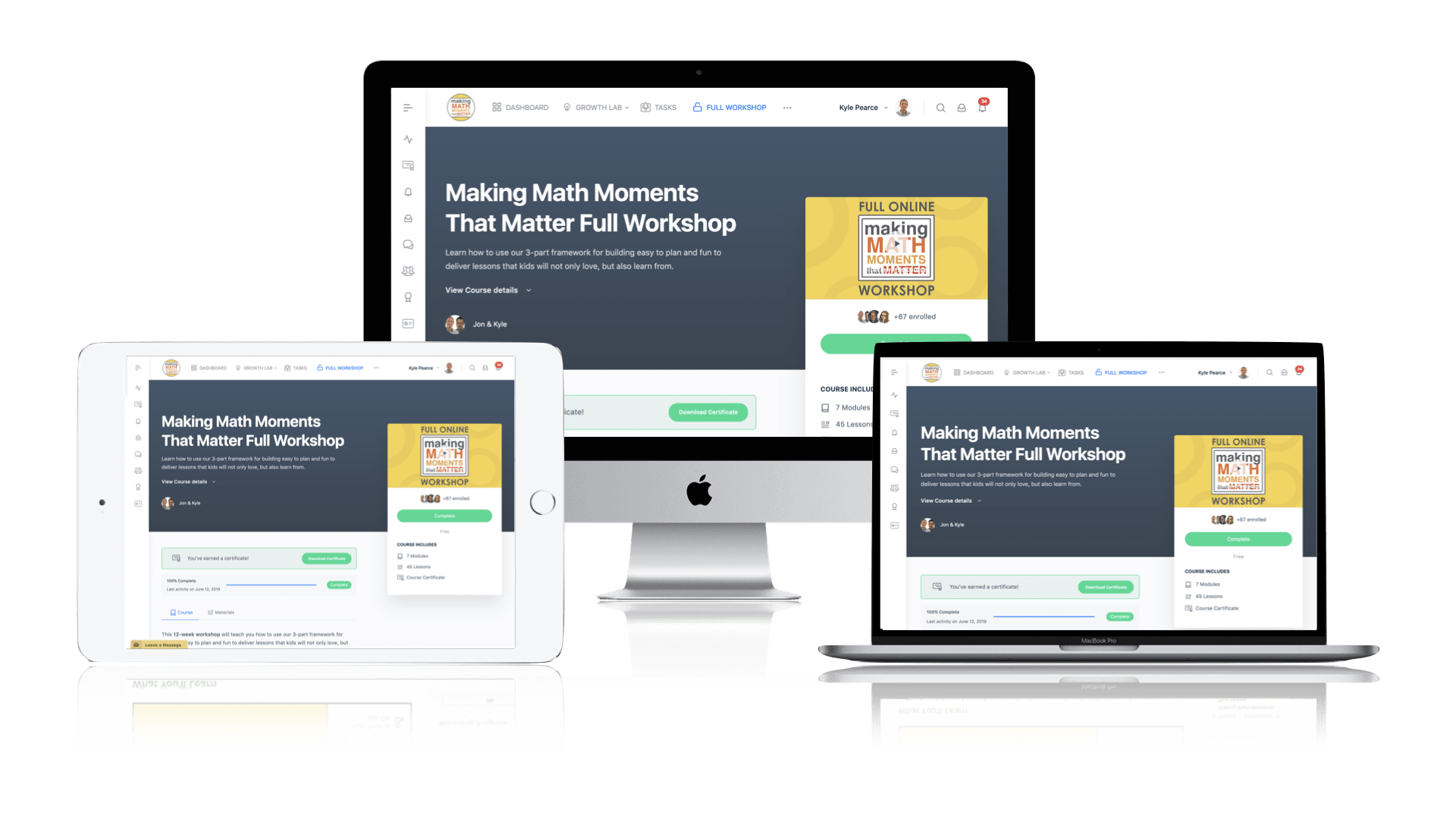
Pedagogically aligned for teachers of K through Grade 12 with content specific examples from Grades 3 through Grade 10.
In our self-paced, 12-week Online Workshop, you'll learn how to craft new and transform your current lessons to Spark Curiosity, Fuel Sense Making, and Ignite Your Teacher Moves to promote resilient problem solvers.
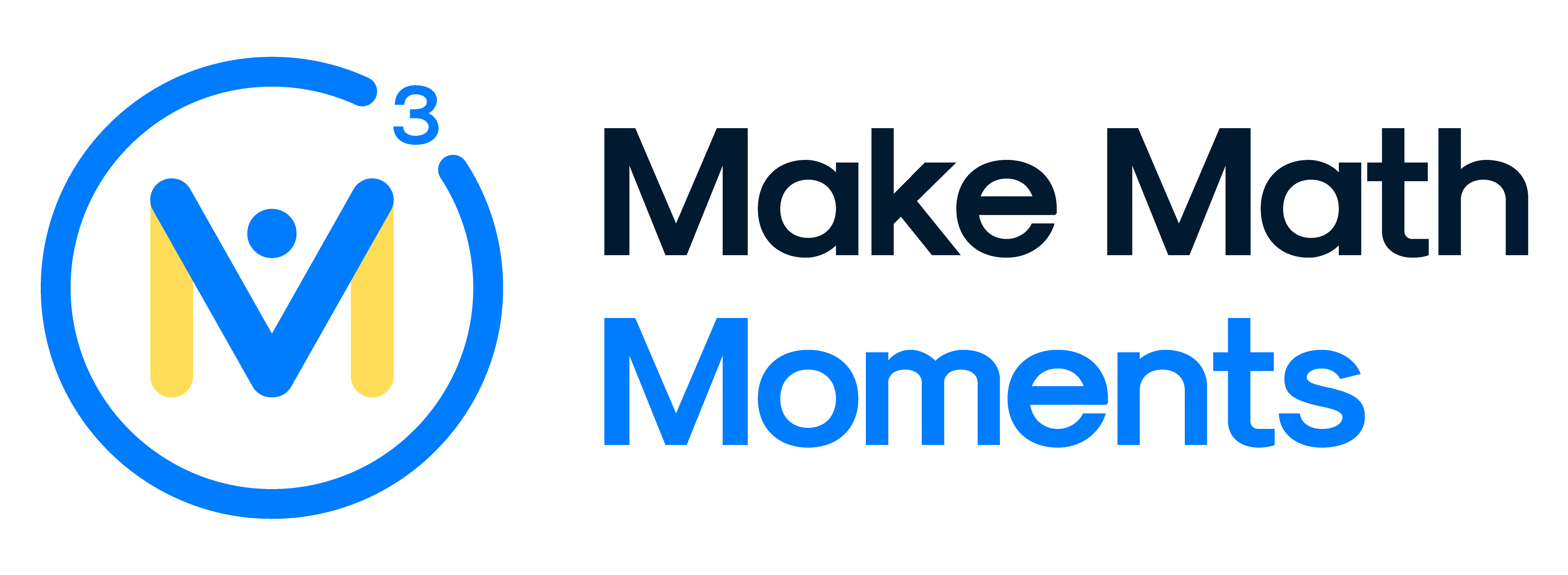



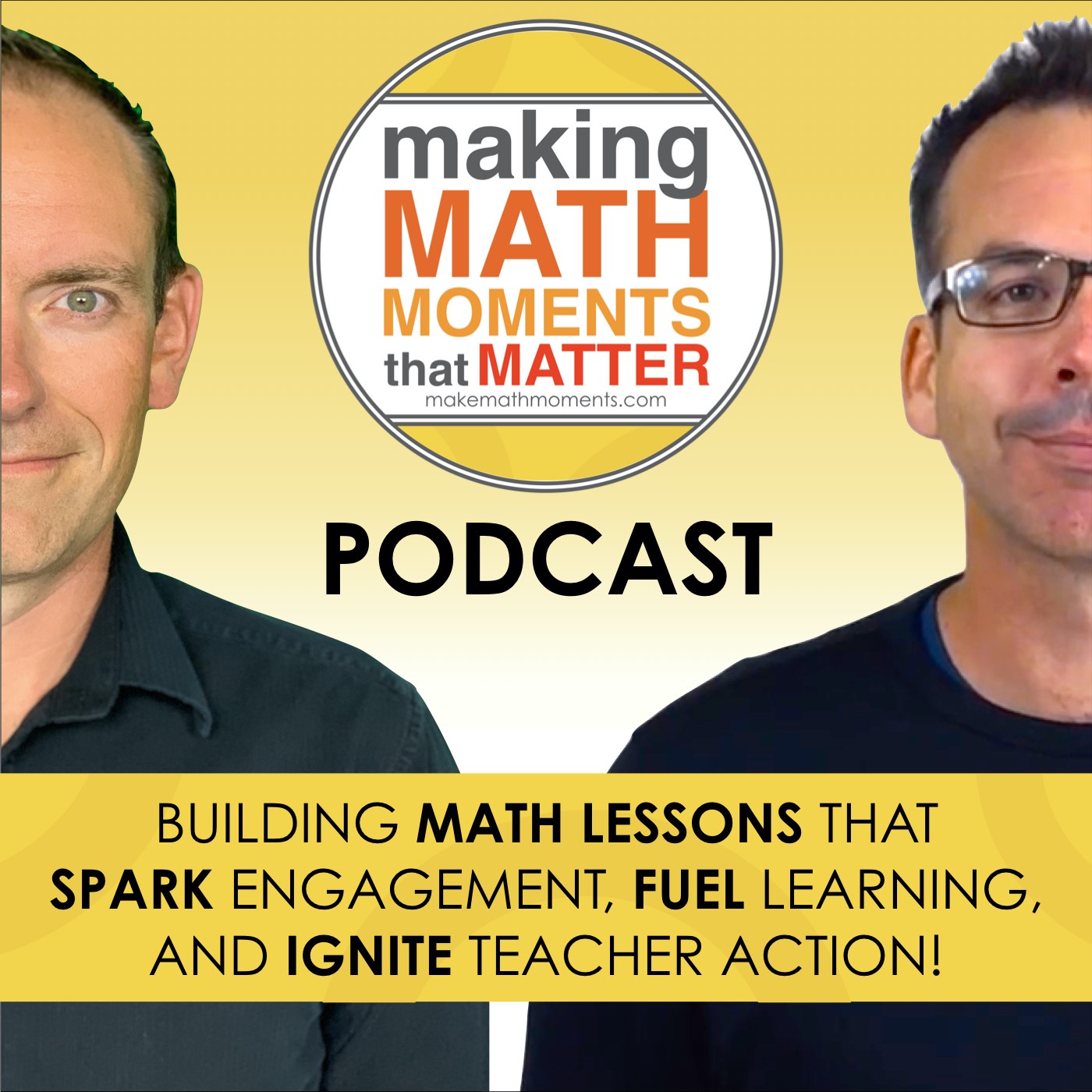
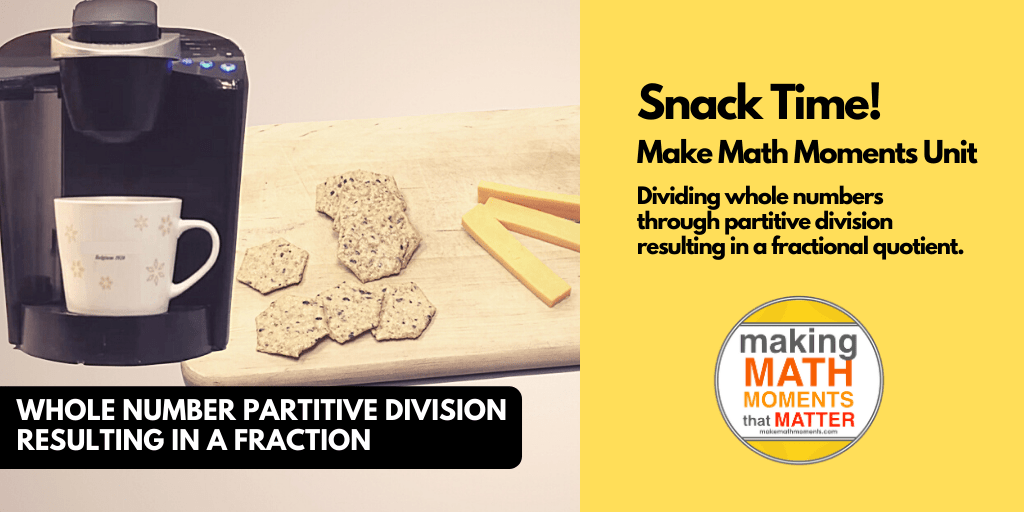

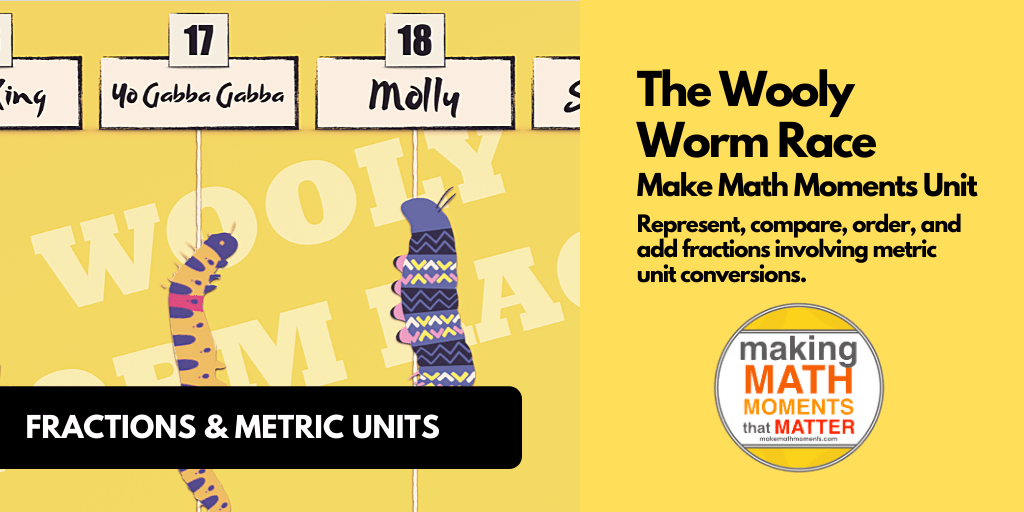
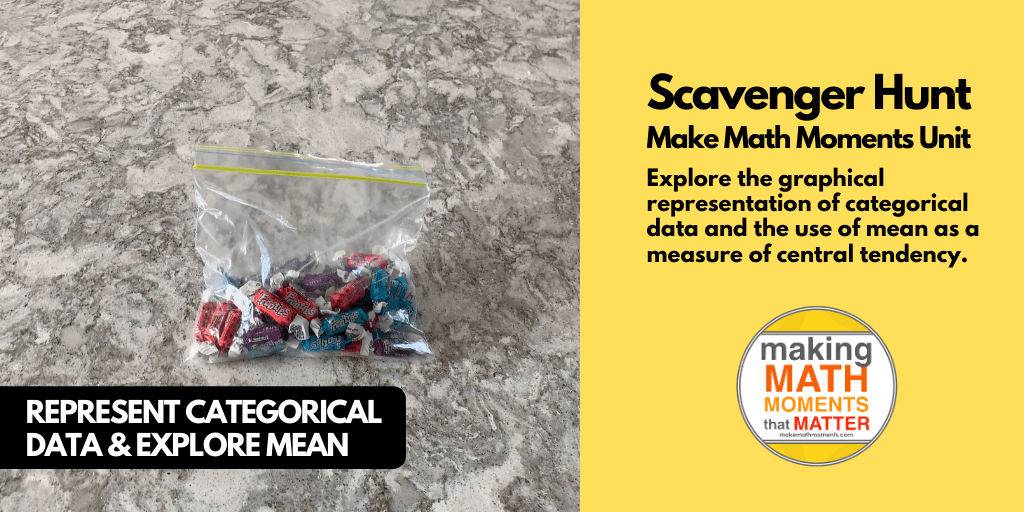
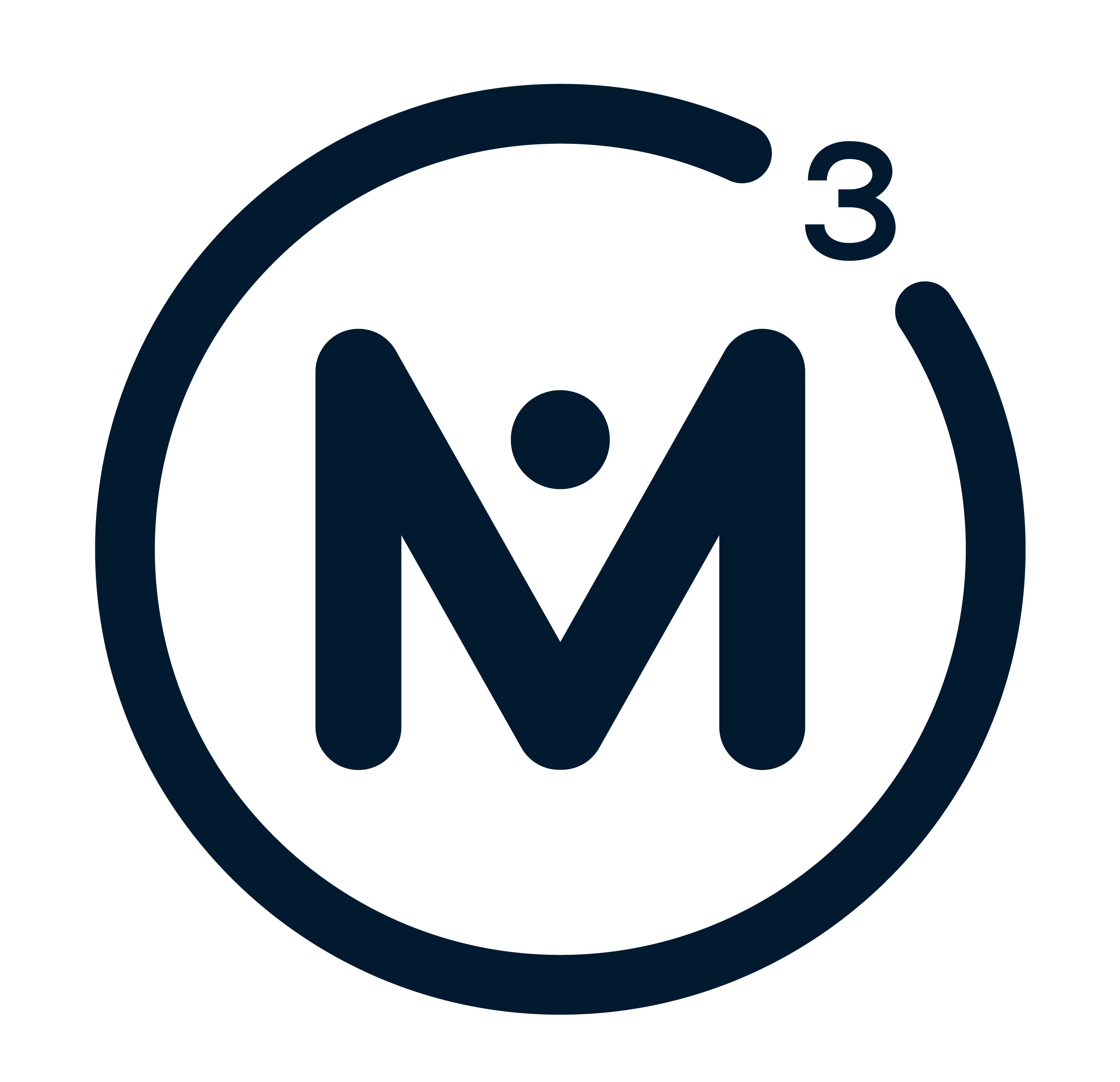
0 Comments